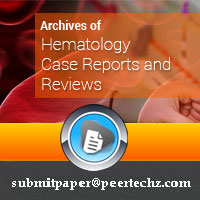Archives of Hematology Case Reports and Reviews
Outcome of blood group system on selfie loving
Muhammad Imran Qadir and Muhammad Hamad Saif*
Cite this as
Qadir MI, Saif MH (2019) Outcome of blood group system on selfie loving. Arch Hematol Case Rep Rev 4(1): 001-002. DOI: 10.17352/ahcrr.000014Objective of the present study was co-relating blood groping with selfie lover. A questionnaire was prepared about Selfie lover. Total numbers of students were 169 students in this research and the average age of students was 18-22 years. All the students give answer according to their blood group. Results completed according to project. We took blood sample of every student of Biotechnology. We took three spots on every slide, spot A, B and D mix antigen A, B and D respectively so we indentified blood group of every student.
Introduction
The classification of human blood based on the inherited properties of red blood cells. Its difference is due to the presence of antigens A and B or the absence of antigen A and B. The discovery of ABO system by karl Landsteiner is a beginning of modern blood banking and transfusion medicine [1]. Rh factor (Rhesus factor) is an inherited protein found on the surface of red blood cells. If the protein is present then the Rh factor is positive and if the protein is absent then Rh factor is negative. Rh factor not caused illness or usually not effect on health. However it may effect on pregnancy [2].
A photograph that you take of yourself usually with a mobile phone is known as selfie. Selfie are often published using social media. we can capture our selfie at any time with our desire selfie may be dangerous, because some people take selfie at dangerous places like, high hills, Pamplona (Spain), Mount Hue (china) and Trolltunga Rock (Norway) etc. Objective of the present study was co-relate blood groping with selfie lover.
Material and Method
Blood Grouping
We took blood sample of every student of Biotechnology. We took three spots on every slide, spot A, B and D mix antigen A, B and D respectively so we indentified blood group of every student.
Project design
A questionnaire was prepared about selfie lover. Total number of students was at about 169 students in this research and the average age of students was about 18-22 years. They calculated and give their views about selfie loving or not .All the students give answer according to their blood group. Result will be completed according to project
Statistical analysis
Statistical analysis performed by using Ms Excel.
Results and Discusion
In blood group A+ total 32 students in which 15 students not like selfie and 17 students like selfie. And In blood group A_ total 2 students present 1 is selfie lover and 1 is not. In blood group B+ total 60 students present, in which 38 students like selfie but 22 not like selfie. In blood group B_ total 5 students present, in which 3 student dislike selfie but 2 students like selfie. In blood group AB+ total 11 students present, in which 5 students like selfie but 6 students dislike selfie. In blood group AB_ 1 student present that likes selfie. In blood group O+ total 56 students present, in which 23 students dislike selfie but 34 students like selfie. In blood group O_ total 12 students present, in which 10 dislike selfie but 2 students like selfie (Table 1).
1. Questionnaire base studies have been given important out comes in current researches [3-10].
Conclusion
It was concluded that students having blood group A-, AB- and O+ were selfie lover. This project was prepared by knowing the views of students of Bahauddin Zakariya University, Multan, Pakistan.
- Qadir MI, Malik SA (2010) Comparison of alterations in red blood cell count and alterations in hemoglobin concentration in patients suffering from rectal carcinoma undergoing 5-fluorouracil and folic acid therapy. Pharmacologyonline, Nl 3: 240-243.
- Qadir MI, Noor A (2018) Anemias. Rare & Uncommon Diseases. Cambridge Scholars Publishing. Newcastle, England. ISBN: 978-1-5275-1807-0. Link: https://goo.gl/f4vDSv
- Qadir MI, Javid A (2018) Awareness about Crohn’s Disease in biotechnology students. GloAdv Res J Med Medical Sci 7: 062-064. Link: https://goo.gl/7LQZNj
- Qadir MI, Saleem A (2018) Awareness about ischemic heart disease in university biotechnology students. GloAdv Res J Med Medical Sci 7: 059-061. Link: https://goo.gl/vTr9Ab
- Qadir MI, Ishfaq S (2018) Awareness about hypertension in biology students. Int J Mod Pharma Res 7: 08-10.
- Qadir MI, Mehwish (2018) Awareness about psoriasis disease. Int J Mod Pharma Res 7: 17-18.
- Qadir MI, Shahzad R (2018) Awareness about obesity in postgraduate students of biotechnology. Int J Mod Pharma Res 7: 14-16.
- Qadir MI, Rizvi M (2018) Awareness about thalassemia in post graduate students. MOJ Lymphology&Phlebology 2: 14-16.
- Qadir MI, Ghalia BA (2018) Awareness survey about colorectal cancer in students of M. Phil Biotechnology at BahauddinZakariya University, Multan, Pakistan. Nov Appro in Can Study 1: 1-5. Link: https://goo.gl/AyYmq9
- Qadir MI, Saba G (2018) Awareness about intestinal cancer in university student. Nov Appro in Can Study, 1: NACS.000515.2018.
Article Alerts
Subscribe to our articles alerts and stay tuned.
 This work is licensed under a Creative Commons Attribution 4.0 International License.
This work is licensed under a Creative Commons Attribution 4.0 International License.

 Save to Mendeley
Save to Mendeley
